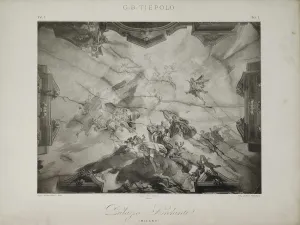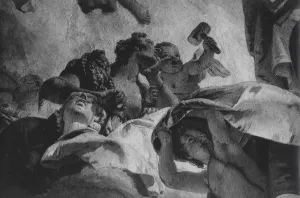Triumph of the Arts and Sciences
Giambattista Tiepolo (1696–1770)
Triumph of the Arts and Sciences, ca. 1730–31
Oil on canvas
21 7/8 × 28 3/8 in. (55.5 × 72 cm)
Museu Nacional de Arte Antiga, Lisbon
© Direção-Geral do Património Cultural / Arquivo de Documentação Fotográfica (DGPC/ADF); photo Luisa Oliveira
This is one of three surviving sketches by Tiepolo for Palazzo Archinto, here reunited for the first time. When Tiepolo painted this one, he had no idea what the quadratura around the fresco was going to look like; he therefore left his figures hovering in a cloudy sky, surrounded by an area of brown ocher color. The allegorical figures that populate this sketch are portrayed under the protection of Minerva and Apollo. At top left is Saturn, winged and with his scythe to signify the timeless nature of the arts and sciences.
Giambattista Tiepolo (1696–1770)
Study for Four Female Figures, 1730–31
Pen, brown ink, and black chalk, on white paper
11 3/8 × 13 3/8 in. (288 × 340 mm)
Civico Museo Sartorio, Trieste
For his fresco cycles, Tiepolo executed a number of preparatory drawings that study compositional solutions for his figurative groups. This is the only extant pen sketch for the Archinto cycle. Here Tiepolo studied the central group of figures for the Triumph of the Arts and Sciences, focusing on the allegorical figures of Literature (or History), Painting, and Sculpture.
Giambattista Tiepolo (1696–1770)
Study of Female Head (recto); Study of Foreshortened Head (verso), 1730–31
Black and white chalk on gray-white paper, recto framed in pen and brown ink
11 1/4 × 8 1/4 in. (285 × 210 mm)
Finnish National Gallery, Sinebrychoff Art Museum, Helsinki
Finnish National Gallery / Jenni Nurminen
The study on the recto, likely drawn from a model, was used for the central figure of Painting in the Triumph of the Arts and Sciences. The focus is on the soft shadows created by the light coming from the left and on the simple line of the contour of the figure's oval face. The study on the verso (upside down) is probably for the bust that Tiepolo placed next to the allegory of Sculpture in the final fresco.
Giambattista Tiepolo (1696–1770)
Triumph of the Arts and Sciences, ca. 1730–31 (destroyed 1943)
From Attilio Centelli and Gerardo Molfese, Gli affreschi di G.B. Tiepolo raccolti da Gerardo Molfese con uno studio di Attilio Centelli (Turin, 1897), pl. 1
Page from unbound book
17 5/8 × 23 1/2 in. (448 × 598 mm)
Azienda di Servizi alla Persona Golgi-Redaelli, Milan
su autorizzazione dell'Azienda di Servizi alla Persona Golgi-Redaelli di Milano
As can be seen from the pre-war photographs, there are several differences between the Lisbon sketch and the final fresco. The addition of the quadratura in the final ceiling meant that the figures were repositioned in relation to the fictive architecture. In the final fresco, Saturn is shown seated on the tympanum of a building; the putto seated under Painting was given wooden squares rather than a mask; and the two putti in the sketch at bottom left and right were eliminated.
Giambattista Tiepolo (1696–1770)
Triumph of the Arts and Sciences, ca. 1730–31 (destroyed 1943)
From Attilio Centelli and Gerardo Molfese, Gli affreschi di G.B. Tiepolo raccolti da Gerardo Molfese con uno studio di Attilio Centelli (Turin, 1897), pl. 2
Page from unbound book
17 5/8 × 23 1/2 in. (448 × 598 mm)
Azienda di Servizi alla Persona Golgi-Redaelli, Milan
su autorizzazione dell'Azienda di Servizi alla Persona Golgi-Redaelli di Milano
Giambattista Tiepolo (1696–1770)
Triumph of the Arts and Sciences, ca. 1730–31 (destroyed 1943)
From Attilio Centelli and Gerardo Molfese, Gli affreschi di G.B. Tiepolo raccolti da Gerardo Molfese con uno studio di Attilio Centelli (Turin, 1897), pl. 3
Page from unbound book
17 5/8 × 23 1/2 in. (448 × 598 mm)
Azienda di Servizi alla Persona Golgi-Redaelli, Milan
su autorizzazione dell'Azienda di Servizi alla Persona Golgi-Redaelli di Milano
Giambattista Tiepolo (1696–1770)
Triumph of the Arts and Sciences (detail), ca. 1730–31 (destroyed 1943)
Unknown photographer, 1940
6 3/4 × 4 3/8 in. (172 × 112 mm)
Azienda di Servizi alla Persona Golgi-Redaelli, Milan
su autorizzazione dell'Azienda di Servizi alla Persona Golgi-Redaelli di Milano
Giambattista Tiepolo (1696–1770)
Triumph of the Arts and Sciences (detail), ca. 1730–31 (destroyed 1943)
Unknown photographer, 1940
6 3/4 × 4 3/8 in. (172 × 112 mm)
Azienda di Servizi alla Persona Golgi-Redaelli, Milan
su autorizzazione dell'Azienda di Servizi alla Persona Golgi-Redaelli di Milano
Giambattista Tiepolo (1696–1770)
Triumph of the Arts and Sciences (detail), ca. 1730–31 (destroyed 1943)
Unknown photographer, 1940
4 3/8 × 6 3/4 in. (112 × 172 mm)
Azienda di Servizi alla Persona Golgi-Redaelli, Milan
su autorizzazione dell'Azienda di Servizi alla Persona Golgi-Redaelli di Milano
Giambattista Tiepolo (1696–1770)
Triumph of the Arts and Sciences (detail), ca. 1730–31 (destroyed 1943)
Unknown photographer, 1940
4 3/8 × 6 3/4 in. (112 × 172 mm)
Azienda di Servizi alla Persona Golgi-Redaelli, Milan
su autorizzazione dell'Azienda di Servizi alla Persona Golgi-Redaelli di Milano
Giambattista Tiepolo (1696–1770)
Triumph of the Arts and Sciences (detail), ca. 1730–31 (destroyed 1943)
Unknown photographer, 1940
6 3/4 × 4 3/8 in. (172 × 112 mm)
Azienda di Servizi alla Persona Golgi-Redaelli, Milan
su autorizzazione dell'Azienda di Servizi alla Persona Golgi-Redaelli di Milano
Giambattista Tiepolo (1696–1770)
Triumph of the Arts and Sciences (detail), ca. 1730–31 (destroyed 1943)
Unknown photographer, 1940
4 3/8 × 6 3/4 in. (112 × 172 mm)
Azienda di Servizi alla Persona Golgi-Redaelli, Milan
su autorizzazione dell'Azienda di Servizi alla Persona Golgi-Redaelli di Milano












